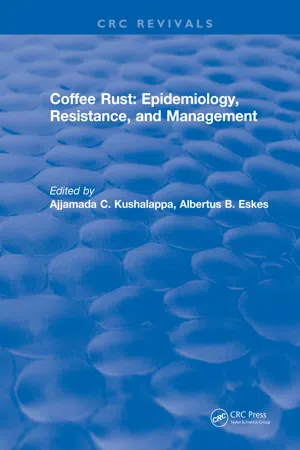Biological Sciences
Life Cycle of Fungi
The life cycle of fungi typically involves both sexual and asexual reproduction. It begins with the germination of spores, leading to the formation of hyphae and mycelium. Under favorable conditions, fungi produce spores through sexual reproduction, which can then disperse and germinate to start the cycle anew. Asexual reproduction involves the production and dispersal of spores without the need for mating.
Written by Perlego with AI-assistance
Related key terms
1 Key excerpts on "Life Cycle of Fungi"
- Ajjamada C. Kushalappa(Author)
- 2019(Publication Date)
- CRC Press(Publisher)
Chapter 2BIOLOGY AND EPIDEMIOLOGY A. C. KushalappaTable of Contents
- I. The Fungus
- A. Life Cycle
- B. Morphology and Development
- 1. Uredinia and Urediniospores
- 2. Teliospores and Basidiospores
- II. Monocyclic Process and Factors Influencing the Fungus
- A. Epidemiological Processes
- B. Quantification of Monocyclic Process
- 1. Survival Ratio
- 2. Period of Process
- 3. Rate
- C. Infection Process and Factors Influencing
- 1. Infection Process
- 2. Factors Influencing Germination and Penetration
- a. Moisture
- b. Temperature
- c. Substrate and Host
- d. Spore Concentration and Distribution
- 3. Factors Influencing Colonization
- D. Sporulation Process and Factors Influencing
- 1. Sporulation Process
- 2. Factors Influencing Sporulation
- E. Dissemination Process and Factors Influencing
- 1. Dissemination Process
- 2. Factors Influencing Spore Dissemination
- a. Wind
- b. Water
- c. Insects and Other Animals
- 3. Daily Rhythm of Spore Liberation and Dispersal
- 4. Relation of Spores in the Air to Disease Severity
- F. Factors Influencing Spore Viability
- III. Polycyclic Process and Factors Influencing Epidemics
- A. Disease Quantification and Characterization
- 1. Disease Progress Curve
- a. Sampling
- b. Disease Intensity
- C. Current Proportion of Disease
- d. Cumulative Proportion of Disease
- e. A Simplified Method to Determine the Cumulative Proportion of Disease
- 2. Intrinsic Infection Rate (k’)
- 3. Infection Rate Based on Host Growth Fixed for Interval (k″)
- 4. Proportion of Area under the Disease Progress Curve (PADPC)
- 5. Proportion of Area under Leaf Removal Curve (PALRC)
- 6. Relation of Disease Incidence to Disease Severity
- 7. Other Disease Parameters
- a. Disease Index
- 1. Disease Progress Curve
- B. Host Quantification and Characterization
- 1. Host Growth Curve
- 2. Host Growth Rate
- 3. Other Host Growth Parameters
- a. Host Density
- C. Quantification of Physical Environment
- 1. Introduction
- 2. Water
- 3. Radiation
- 4. Wind
- D. Factors Influencing Disease Development
- 1. Host
- 2. Pathogen
- 3. Environment
- a. Rain
- b. Temperature
- c. Altitude
- E. Interactions and Seasonal Periodicity
- A. Disease Quantification and Characterization
Learn about this page
Index pages curate the most relevant extracts from our library of academic textbooks. They’ve been created using an in-house natural language model (NLM), each adding context and meaning to key research topics.
